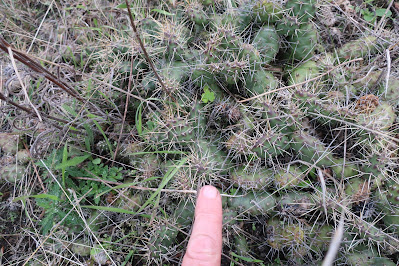I had a venture on Orcas Island (One of many this year). These trees on the edge of a rocky shoreline slope got a bit of my attention distracting me from the geology.
The evergreen is a Douglas fir. Likely a bit sculpted by wind and occasion salt spay and the rather harsh growing conditions on a bedrock slope with very thin to no soil. The woody brush was what got my attention.
Oak leaves!
When I took the picture above I stuck my fingers into the image for scale. I did not see another plant tucked partly under the low oak. It was only after pulling my hand back that I noticed the plant.
This was a first for me on Orcas. I have seen this cactus on Lopez Island and Decatur Island. I had help spotting them on those previous sightings. The picture below shows that the cactus does not stand out.
The cactus was was often just above the salt spray line. Just enough of a harsh spot to not get out competed by other plants. The Orcas site is on the drier side of the island as the island is situated within the rain shadow of the Olympic Range.
It is a pretty rare plant in western Washington and is limited to the Olympic rain shadow with reports of the cactus on Whidbey Island and northwest Jefferson County on the Olympic Peninsula. This species is also present in the Okanogan area of north central Washington along with a couple of other species of cactus. Its presence in the Okanogan indicates it is highly tolerant of cold weather.
Opunntia fragillis - Brittle prickly pear cactus
Once I spotted the first patch, or it spotted me, I started looking for other patches and found several.
It is a pretty rare plant in western Washington and is limited to the Olympic rain shadow with reports of the cactus on Whidbey Island and northwest Jefferson County on the Olympic Peninsula. This species is also present in the Okanogan area of north central Washington along with a couple of other species of cactus. Its presence in the Okanogan indicates it is highly tolerant of cold weather.
Perhaps this species pioneered the barren ground after glacial ice retreated and has only hung on in places where other plants have had a harder time. There are theories that these plants on the west side may have been partially nurtured by First Nations peoples. Given the above setting, that seems very possible as it was an appealing site.
Domico, Terry. Brittle Prickly-Pear Cactus (Opuntia fragilis) in the San Juan Islands and Puget Sound Region of Washington State. Douglasia Occasional Papers, Vol. 7, No, 1, pp. 37-50, 1999.










4 comments:
Very interesting postulation about First Nation nurturing their growth.
Ha! That cactus jumps. You could be cruising through the shrubs (unknowingly) and before you know it, one of those leaves had jumped up and grabbed you behind the knee. That seems to be a favorite spot. The side of your shoe, also. And dogs' paws.
It also hides in Chelan, Douglas, and Grant counties.
I also liked your First Nation speculation
This rare species also has me wondering about the spotty findings of poison oak and poison ivy in Western WA. Any thoughts on their distribution?
Paul: I have been too bust and just now saw your comment. I have found the poison oak distribution to be fascinating. The most prevalent area I have seen it is on the northeast side of the Olympics along Hood Canal. That is a summer time hot spot. I got a pretty good rash from one venture through a clear cut -- was a half hour of brushy walking before I realized that much of the brush was poison oak.
Post a Comment